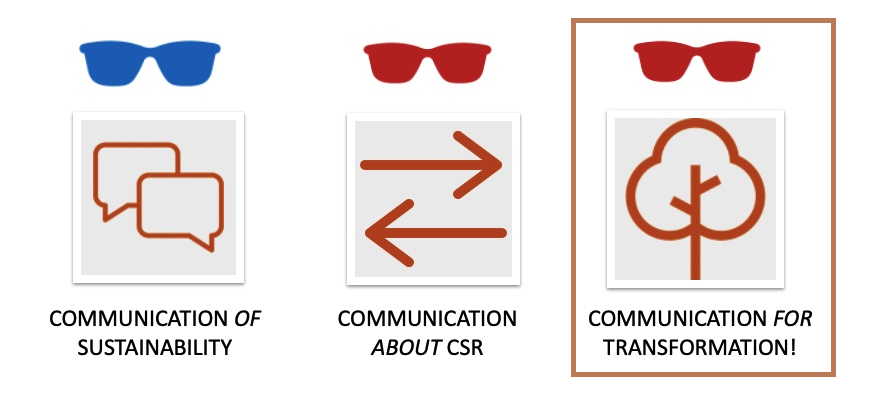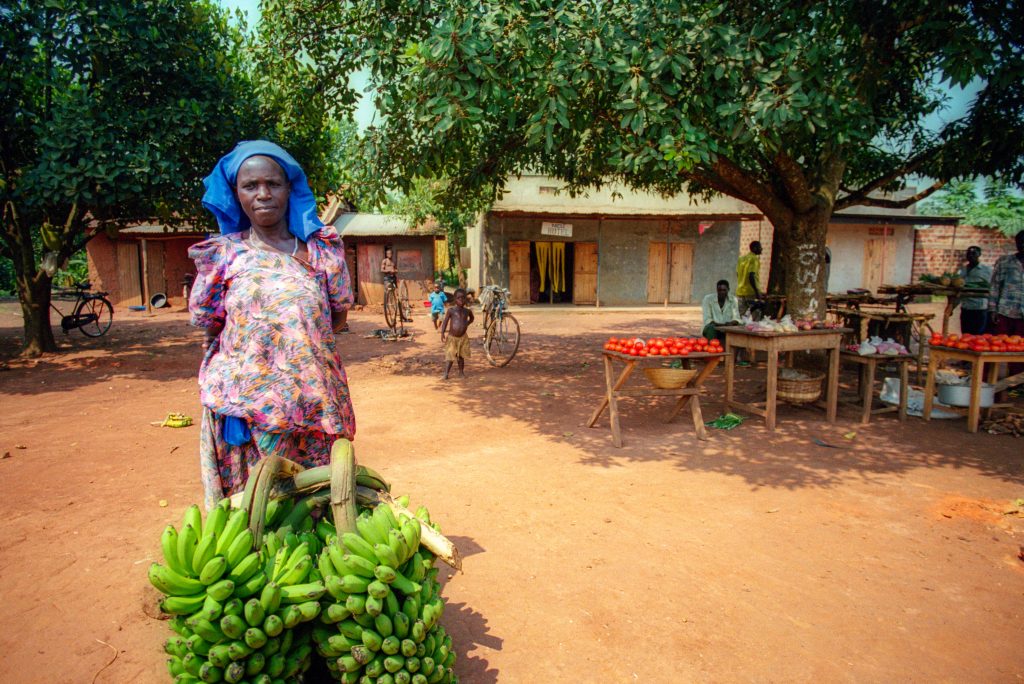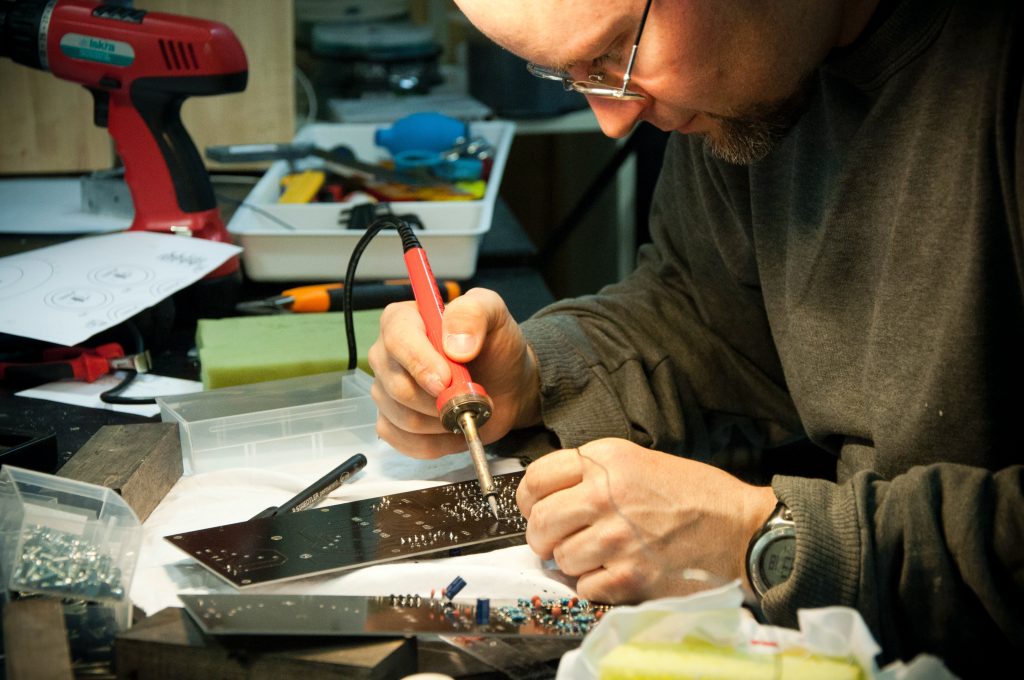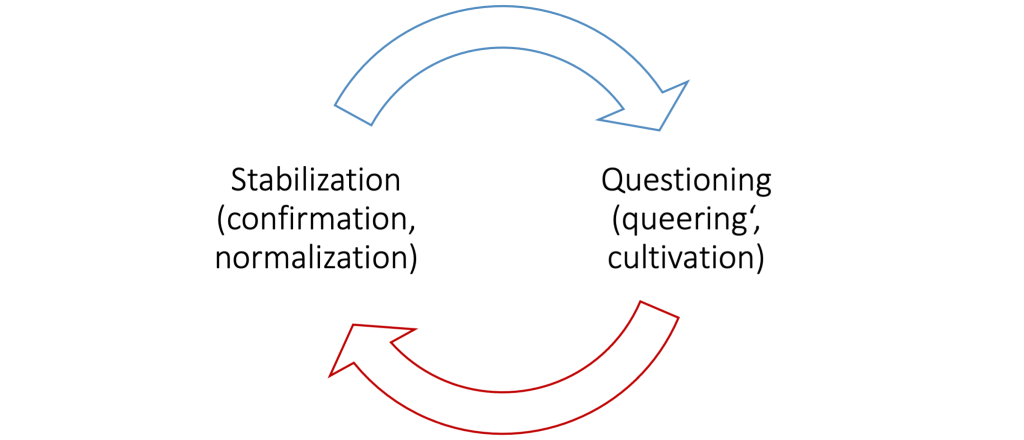III.4. Communication for Sustainability
Franzisca Weder
The lady…
I decided to go home. It’s been a long day. I passed a toy shtop, displayed were cars, puzzles, board games and books. But what was that? There, in the ‘pink’ corner of the shop window, I spotted a new set of Barbies – a set of four Barbie-dolls, labelled as the “Barbie ECO-LEADERSHIP TEAM“. A boy created with the Jane Goodall Institute. The Gorilla Lady! OMG. I couldn’t believe it … I took a photo.
Something is changing, I thought to myself. Something is happening here. If an ‘Activist’, a ‘Conservation Scientist’ and even a ‘Chief Sustainability Officer’ are now the new role-models for kids, then social change and transformation towards a more sustainable future is actually happening. I rang the lady …
In part II of this book we introduced the two main theoretical paradigms that direct different understandings and interpretations of communication. The pragmatic, functionalist paradigm on the one hand and the (social) constructivist paradigm on the other hand. This was the starting point to the differentiation between communication of CSR and sustainability and communication about responsibility and sustainability as two complementary perspectives. CSR communication, and CSR, sustainability and ESG reporting in particular were discussed in chapter III.2., where communication is used as tool or instrument to inform stakeholders and certain target audiences about CSR activities and programs. In chapter III.3, we defined the public discourse about corporate responsibility and the crucial role of the media in facilitating this discourse about CSR and sustainability. Based on existing research and practical insights, we stated that while the climate change story and the negative side of CSR communication (greenwashing) are represented in the media and thus in public discourses, the sustainability story, the story about sustainable development and a more balanced human-nature relationship, is less present in the media.
However, the sustainability story is told – maybe less in the media, but more in other forms of communication and conversational formats. Therefore, in this final chapter we want to open a new dimension to CSR and sustainability communication, the dimension of communication for sustainable development and transformation.

Graphic: Dimensions of CSR communication” by Franzisca Weder
This is based on a critical and constructivist perspective, but goes beyond. If we integrate thinking from organizational communication scholars who define communication as constitutive for organization and further talk about communication as ‘organizing’ process in our society (Schoeneborn, 2011; Putnam & Nicotera, 2008; Taylor & Van Every, 2010), then communication is even more relevant for any form of societal transformation processes. Whenever we communicate, we organize. That’s the claim for these authors and scholars following the CCO-perspective (communicative constitution of organizations). This includes – as said – social constructivist thinking on sense- and meaning making, where communication is explained as“enactment of the social world, constituting it through text and verbal descriptions that are communicated to and negotiated with others” (Berger & Luckmann, 1966). But it offers two more key aspects:
- if communication ‘organizes’ interpersonal relationships, connections between organizations and their stakeholders as well as the emergence and manifestation of new values and norms within organizations and beyond, then narratives play a key role (Weick, 1995; Mumby, 1993). Based on the understanding of humans as ‘storytelling animals’ (MacINtyre, 1981, p. 201), we can agree with Mumby that narratives provide individuals accounts of any processes of organizing (1987, p. 113). A narrative or a story is the organizing element and thus the manifestation of certain cultural pattern or norms.
- an additional important element to look at in transformation processes are conversations, which are described as sense making in action. Sense making can then further be explained as process of narrativization or narrative-making. A narrative consists on hidden patterns in conversations, these patterns are the “organization” of a conversation (Taylor & Van Every, 2011, p. 21). A conversation is basically the unit or sequence that can be looked at where communicating as organization and therefore narrativization happens.
Therefore, communication for transformation is less directed or one-way, it is rather self-organized and participatory and happens in a specific context as ‘many-to-one’ process. One key character is that communicating (instead of communication) is open, it includes a process of ‘cultivation’ where new patterns, new norms can emerge.
Communication for Transformation
Direction / mode of communication:
Participative, self-organized, many to one
Function:
Participative, sense- and meaning-making, social change, cultivation
In this chapter, we will focus on ‘communicating’ complementary to communication to capture a wider range of conversations that are part of a socio-economic transformation. We will explore these conversations again in the different societal areas (civil society, education, corporate world etc.), and then focus on the cultivation of a new norm (sustainability) in those conversations.
Civil Society organizations: Nonprofit and nongovernmental organizations, social and environmental movements and networks are often a form of self-organized cooperative. They work collaboratively and participatory and are not (only) focused on exert political pressure but also communicating for change by offering a counter-narrative to the existing and often more established ones. One example is Extinction Rebellion (XR). From the beginning, Extinction Rebellion stimulated local conversations at the points of action and rebellion and on a public level and transformed the global conversation about and around the climate crisis. By means of ‘civil obedience’ and ‘rebellion’, they led political institutions and even nations to declare a climate emergency. With that, XR had changed the conversation from crisis to an ’emergency’, from global warming to social and ecological collapse and mass extinction. From a theoretical perspective, narrating the socio-ecological problems in a new way has established new patterns of meaning and cultivated a new understanding of ‘ecological emergency’ and opened a wider scope of ways to act.
Education institutions have identified different ways to create conversational spaces for participation in change processes. They encourage staff and students and related stakeholder (future students, parents, local community) to take action and authorship, in the classroom and beyond. There is an increased awareness for the need for inclusive, place based and local projects and participatory approaches. So called ‘participatory communication’ facilitates equitable engagement of individuals, groups and stakeholders in change processes. Individuals and groups are involved in and impacted by these communicatively facilitated change processes. One example is the PEATLI project organized by the Center for Communication and Social Change at the University of Queensland (Brisbane / Australia). Peatli stands for ‘Peatland community Engagement And Transdisciplinary Learning – Indonesia’ and brings students from different disciplines (law, environmental management, communication) to Indonesia to conduct a multi-stakeholder consultation exercise at national, provincial, district and community level:
“This consultation is focused on one complex issue of concern for the host organisation, which is the restoration and utilisation of degraded peatlands. Based on these stakeholder consultation, students will formulate recommendations for enhanced community engagement to support the sustainability of projects and programs run by the host organisations. For the fieldwork, PEATLI participants (from UQ) team up with students from Universitas Indonesia or Universitas Brawijaya who will help with translations” (The University of Queensland, n.d.).
With this project, students take not only action but they also create impact and develop authorship for transformation process in a specific (place-based, local) context.
Similar to education institutions, scientific institutions take part in a social transformation process by not only fostering sustainability related research, but also in a way of creating a normative approach in their work. This includes transdisciplinarity and a stronger focus on translating research insights into practice. One example is the Center for Climate Change Communication at George Madison University (Washington), which has the mission to:
“…develop and apply social science insights to help society make informed decisions that will stabilize the earth’s life-sustaining climate, and prevent further harm from climate change” (Center for Climate Change Communication, 2020).
Visit Our Programs to learn more about their activities.
Another example is The International Environmental Communication Association (The IECA), a professional nexus of practitioners, teachers, scholars, students, artists and organizations engaged in research and action to find more ethical and effective ways to communicate about environmental concerns in order to move society towards sustainability. Their mission is one way to communicate for change, “to foster effective and inspiring communication that alleviates environmental issues and conflicts, and solves the problems that cause them” (IECA, n.d.).
Political institutions are first of all responsible for the implementation and the stabilization of structures that enable sustainable development.
One example is the Global Compact, the greatest corporate sustainability effort in the world created by the UN’s Organisation for Sustainable Business. The Global Compact is made up by more than 20,000 members throughout 160 nations. Currently, Norway is one of about 70 local UN Global Compact networks spread across all continents. One of the regional networks with the fastest growth in membership is UN Global Compact Norway (Global Compact, 2023).
The UN Global Compact, which includes more than 10,800 businesses based in more than 150 countries, is the largest worldwide corporate sustainability project. The CEO of the participating companies must agree to the programme because it is voluntary and based on principles. The 10-principle framework directs ethical business in the areas of labour, environment, anti-corruption, and human rights, and it connects these efforts to the SDG’s goals (BH4S, 2023).
But political institutions need to go beyond stabilization and question these larger frameworks; what does it mean for small and medium sized corporations? What does in mean in different cultural contexts? What does a global compact mean on a local level: one example for a decentralized approach and a translation of the global compact areas is to strengthen local organizations while reducing dependence on Governments and Administration are so called Self-Help-Groups, which engage the community in decision-making processed. The SHG in Palayanur village in Tamil Nadu trained 100 villagers in nursing and computer skills, enabling more lucrative employment opportunities and greatly uplifting the socio-economic conditions in the village. This shows the effectiveness of involving local communities in identifying local solutions for their specific local challenges.
Part of media corporations responsibility (see chapter III.3) is to facilitate conversations about climate change, socio-ecological transformation processes and sustainable development on a larger scale. There are various related media initiatives, i.e. editorial sections that have been established over the years to stabilize the public discourse on the crisis and possible solutions. One example is the Environment section of The Guardian.
At the beginning of the chapter, we introduced communication as organizing principle, as new pattern that is introduced in form of a new narrative. Communicating in a different way re-organizes communication. Going beyond opening a new editorial section as conversational space, we can also refer to the Guardian regarding their decision in 2019 to reframe climate change to climate crisis and global warming to global heating. Corporations and business are not only responsible for their own activities. On the one hand, they establish, manifest and maintain new organizational structures to secure CSR within the organization. One example are management standards, like ISO 26000 (2023).
ISO 26000 is the international standard for companies and organisations dedicated to conducting business in a socially responsible manner. After five years of negotiations involving numerous various parties around the world, the standard was finally introduced in 2010. It was developed with input from government, NGOs, business, consumer, and labour organisations from all around the world, thus it reflects an international consensus.
The application of ISO 26000 is increasingly seen as a means of evaluating an organization’s commitment to sustainability and its overall performance. Unlike several other well-known ISO standards, ISO 26000:2010 gives recommendations rather than requirements, hence it cannot be certified to. Instead, it assists in defining social responsibility, assisting companies and organisations in turning ideals into practical actions, and disseminating worldwide best practises in the area. No matter what they do, how big they are, or where they are located, all kinds of organisations are targeted.
But again, communication for sustainability and participating in socio-ecological transformation processes goes beyond. As a corporate citizen, they participate in social change and can help to cultivate new principles of action like sustainability. They are continuously communicating for change by for example displaying solutions and collaborating with regional and local players, funding bodies and civil society organizations to enable change. One case is the following:
“One-acre farm is a highly profitable, mixed-farm near Lake Victoria in Uganda, East Africa. The small farm was designed by farmer and veterinarian Dr. Emma Naluyima. By emulating nature’s cyclical and regenerative processes, Emma’s farm generates multiple revenue streams and significantly reduces running costs and waste. This leads to much higher profits” (Ellen MacArthur Foundation, n.d.).
This is a case study funded and supported by the Ellen MacArthur Foundation, the world’s leading circular economy network, bringing together businesses, policymakers, innovators, universities, cities, philanthropic organisations and thought leaders to build and scale a circular economy, with a long list of strategic partners, including Ikea, Gucci, Philips and Cocoa Cola.

Photo by Mick Haupt on Unsplash
Not only for business, communication for sustainability and transformation goes beyond reputational aspects; it does have effects on corporate behavior, management and on a larger scale on the logic of the economic system. One example for a not-business or not-market focused organization is a so called “repair café“. These small organizations or better: locations provide people with a place to gather and work on repairing everyday objects (electronics, devices, computers, bikes, clothing etc.). They are a non-capitalist initiative, a new type of organization that establishes new patterns of behavior.

Photo by Blaz Erzetic
Repair cafes are an example for small non-commercial repair ecosystems, the organizing principle and ‘normative framework’ that drives them is a counter narrative to the consumer and “throwaway” society and capitalistic economy. They represent a different relationship to objects and how this can be transmitted by practicing repair and teaching individuals who are not familiar with the issue of product durability, socializing them through a new practice of new patterns, to a new ‘reflex of repair’ (Madon, 2022).
The relevance of sustainability-related communication to achieve sustainable development (Newig et al., 2013; Weder, 2021) becomes obvious looking at repair cafés. Communication for sustainability and transformation includes:
- Participation through introducing bottom-up concerns, ideas & solutions into the society,
- Problematization by creating societal awareness of sustainability related problems,
- Deliberation, antagonism by highlighting different perceptions & narratives of sustainable development, pluralvocacy (framing), embracing conflicts, and
- Capacity building by enabling individuals to take authorship, to play an active role in/for sustainable development.
- Additionally, a repair café creates conversational spaces as ‘outcome’ or ‘organized form of communication’ that emerges from communicating in a specific way. We remember: narratives consist on hidden patterns in conversations, these patterns are the ‘organization’ of a conversation, which is then basically the unit or sequence that can be looked at where communicating as organization and therefore narrativization happens.
Cultivation of Sustainability
As outlined in this chapter, socio-ecological change and transformation related to a new norm (sustainability) including the formation of new patterns of behavior can happen through sense- and meaning making processes and participatory forms of communication. And every conversation has the potential to do that.
One more tangible example of how communication organizes and creates contingent conversations and of how communication is actually sense- and meaning making is framing. Framing happens in every communication process and is a way of organizing communication. Framing includes the definition of a problem and moral evaluation and judgement (Entman, 1993). Other authors dealing with framing, for example Semetko and Valkenburg (2000) or Cappella and Jamieson (1997) also speak of framing as problem definition, justification and evaluation as well as as a loose proposal for solutions. Additionally, there are authors who define ‘Issue-specific frames’ (de Vreese , 2005) as patterns that structure and organize communication. More generally, a frame is a pattern of interpretation (Weder, 2021) that builds ‘communicative tension’ and potentially leads to further communication and structures a conversation and even discourses at a higher social discourse level. Frames can also imply a positive or negative sentiment, can be prognostic or diagnostic (Snow & Benford 1992) or even motivational. Framing is always linked to a specific cultural context (Gamson et al. 1992, p. 384; p. 384; van Gorp 2007: 60) and has the potential to change cultural patterns .
The emergence of new patterns or interpretations of for example objects and their durability in a repair cafe concept creates a certain communicative tension that stimulates change. The tension between opposing positions arises from the fact that one’s own position is classified as ‘should’, the counter-opinion as ‘being’. The power of attraction between the two positions in the sense of cognitive dissonance (Festinger, 1962) leads to attention and interest in starting disputes and negotiation processes, always in search of consensus. (Weder, 2022). The less a position corresponds to the ‘obvious’ or established patterns of interpretation, the more irritating it is perceived and thus the more cognitive processing it simulates.
Thus, the less an event or the ‘logic’ of a repair café fits into existing cultural interpretation patterns and thus corresponding overarching discourses and narratives, the sooner the process of problem definition, evaluation, the comparison between ‘being’ and ‘should’ begins. This process can also be initiated, stimulated and strategically planned. With a concept of dialectic in mind (Ketschau, 2019), communication for transformation on the one hand includes the stabilizing elements that have been discussed in the previous chapters, but on the other hand it requires active questioning, or problematization (Weder, 2021b), processes of contestation, stimulation of dissent and an ongoing testing and legitimatization of (hegemonic) arguments and cultural patterns (Wodak, 2018).
With the difference between perspectives transformation can be collaboratively generated (Milstein & Pulos, 2015). With questioning and related conversations and negotiation processes, sustainability can be turned into a field of conversational contestation – which is a very different approach to norms, a transformative perspective for sure, which brings in a contextual and cultural dimension, as mentioned above (Weder, 2023).
Good to know about … culture
To understand communication for transformation as cultivation process, we need a broad understanding of culture, which refers to all domains of human life, or a specific way of life. Culture includes all our activities requiring the transfer, understanding or construction of meaning and value (Hall, 1997); the vision of a culture of sustainability is described in terms of a ‘culture of moderation’, a ‘culture of attentiveness’ towards plants, animals or humans, or as ‘culture of preservation and nurture’ (Cernea, 1993). This is more recently explored in the context of organizational culture, explaining sustainability related organizational culture as shared beliefs about the importance of social responsibility and human-nature balance (Iacob, 2020). This also includes the understanding of communication having a collaborative character – inside and outside of organizations (Ketprapakorn & Kantabutra, 2022).
Culture enables, integrates, coordinates, organizes and brings together all aspects of sustainable action (Weder, 2022, 2021; Soini & Dessein, 2016) and is therefore the root and also the result of all human action and human decisions. Sustainable social practices – again, as in repair cafes, see above – can have a cultural impact if they relate to the principle of sustainability. Then, cultivation means reproducing sustainability, by communication sustainability can be culturally anchored as a new norm.
Summary – most important take aways
Communication for sustainability and transformation is based on a constructivist understanding of communication – but goes beyond. A critical and reflective perspective on communication is added which includes processes of problem definition (problematization), moral evaluation, and questioning. Conversations are the overarching sequence of organizing communication processes. Therefore, whenever we, groups, or organizations communicate, they organize – they create meaning and potentially new norms like sustainability. The main take away from this chapter is that communication is not only an organizing but also a performative process and plays a crucial role for (bottom-up) transformation – and the deep naturalization of a new norm.

This naturalization of a new norm happens through a dialectic process of stabilization (institutionalization of the sustainability goals) and questioning and reflection.
Further reading…
Madon, J. (2022). Free repair against the consumer society: How repair cafés socialize people to a new relationship to objects. Journal of Consumer Culture, 22(2), 534–550. https://doi.org/10.1177/1469540521990871
Fairclough, N. (2001). The dialectics of discourse. Textus, 14(2), 231-242.
Weick, K. E., & Browning, L. D. (1986). Argument and narration in organizational communication. Journal of Management, 12(2), 243-259.
Jablin, F. M., & Putnam, L. (1990). Organizational communication. Human communication: Theory and research, 156-182.
Schoeneborn, D., Blaschke, S., Cooren, F., McPhee, R. D., Seidl, D., & Taylor, J. R. (2014). The three schools of CCO thinking: Interactive dialogue and systematic comparison. Management communication quarterly, 28(2), 285-316.
Krzyżanowski, M. (2020). Normalization and the discursive construction of “new” norms and “new” normality: Discourse in the paradoxes of populism and neoliberalism. Social Semiotics, 30(4), 431-448.
Weder, F. (2022). Nachhaltigkeit kultivieren. Öffentliche Kommunikation über Umwelt, Klima, nachhaltige Entwicklung und Transformation. Communicatio Socialis (ComSoc), 55(2), 146-159.

